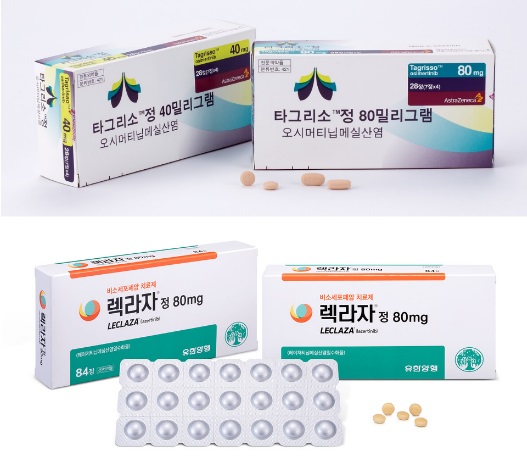From Jan. 1, AstraZeneca's Tagrisso (osimertinib) and Yuhan Corp.'s Leclaza (lazertinib) will get health insurance coveraget for the first-line treatment of locally advanced and metastatic non-small cell lung cancer (NSCLC).
Koselugo (selumetinib), developed by AstraZeneca and MSD, will be also covered by health insurance for treating inoperable plexiform neurofibromas in children and adolescents three and older.
The Ministry of Health and Welfare held the 28th Health Insurance Policy Deliberation Committee on Wednesday and approved the “Amendment to the Drug Reimbursement List and Benefit Ceiling Amount Table” to that effect.

Tagrisso and Leclaza were set to be covered for "first-line treatment of locally advanced or metastatic NSCLC with EGFR exon 19 deletion or exon 21 (L858R) substitution mutation.
The coverage expansion comes six years after Tagrisso was approved in December 2017 for "treating patients with EGFR T790M mutation-positive locally advanced or metastatic NSCLC who have been previously treated with an EGFR-TKI," and two and a half years after Leclaza was approved in July 2021.
Tagrisso will be available to 1,352 patients per year at a cost per patient of 68.1 million per year (about 3.4 million won with a 5 percent co-pay). Under the three risk-sharing arrangements - reimbursement, aggregate limit, and initial treatment cost reimbursement - Tagrisso's benefit ceilings are 101,759 per 40 mg tablet and 190,123 won per 80 mg tablet, a 10 percent reduction from the previous ceilings.
Leclaza will treat 1,282 patients per year at a cost per patient of 68.7 million won (about 3.43 million won with a 5 percent co-pay). Under the two risk-sharing agreements -- reimbursement and capitated -- the reimbursement ceiling for Leclaza is 63,370 won per patient, an 8.1 percent reduction from the previous ceiling.
With the expanded reimbursement for Tagrisso and Leclaza, patients expecting the first-line treatment to be covered through public petitions will be covered from the beginning of treatment, reducing their financial burden from about 680 million won to 3.4 million won per year.

Also, the panel set Koselugo to get reimbursement for "treating pediatric patients aged 3-18 years with neurofibromatosis type 1 with inoperable plexiform neurofibroma (PN)."
In January this year, the government amended the regulations to allow drugs that improve the quality of life of children to be exempted from economic evaluation to increase their access to new drugs for serious and rare diseases. Koselugo is the second case to be covered by the amendment.
The number of patients eligible for Koselugo is about 180 per year, and the estimated claim amount was agreed to be 37.59 billion won ($28.84 million) under three risk-sharing contracts -- reimbursement, capitation, and initial treatment cost reimbursement. The finalized reimbursement ceilings for Koselugo are 95,347 won per 10mg capsule and 235,464 won per 25mg capsule.
Until now, the annual cost of Koselugo per patient has been about 280 million won, but the health insurance coverage will lower the cost for patients up to a maximum of 10.14 million won.
Related articles
- MSD's Keytruda wins 2 new approvals for 1st-line gastric cancer, early-stage lung cancer
- Yuhan secures full approval for Leclaza as 1st-/2nd-line treatment for NSCLC
- ‘Leclaza shows efficacy on patients with lung cancer metastasized to brain’
- AstraZeneca Korea expands indication for Ultomiris to treat generalized myasthenia gravis
- AZ says Tagrisso effective in unresectable stage-3 EGFRm NSCLC
- Tagrisso-chemo combo expands indication for 1st-line NSCLC treatment

